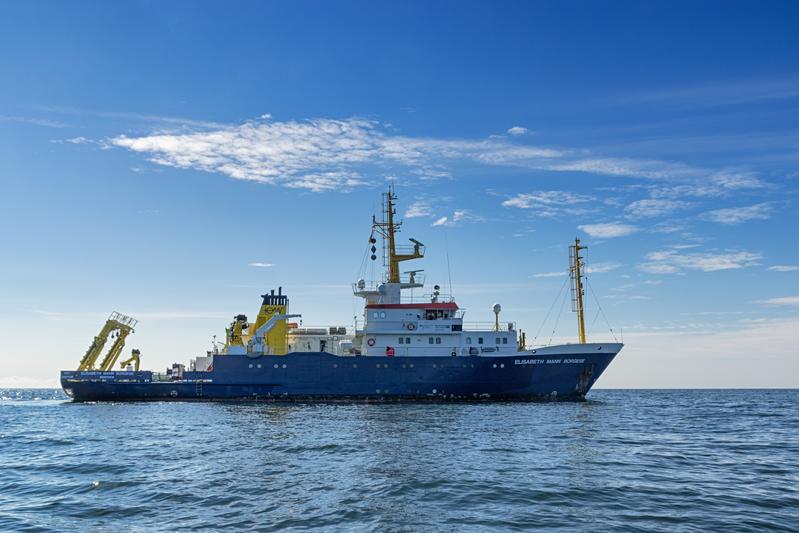Turbulent Jubilee Expedition: FS ELISABETH MANN BORGESE starts 200th research cruise
On November 17, 2018, the research vessel ELISABETH MANN BORGESE will leave its home port Rostock Marienehe for its 200th cruise. The destination is the Gotland Basin in the central Baltic Sea. Here, the scientific team headed by the oceanographer Lars Umlauf from the Leibniz Institute for Baltic Sea Research Warnemünde (IOW) will be investigating small-scale turbulent mixing processes, which play an important role in the oceans’ energy budget. A better understanding of these processes by will ultimately contribute to the improvement of climate predictions. The ELISABETH MANN BORGESE is owned by the state of Mecklenburg-Vorpommern and has been serving Baltic Sea research since 2011.
The ship, originally named SCHWEDENECK, was built back in 1987, at that time for the use of the military technical service of the German navy. In 2011, after extensive restoration and conversion measures, it was transferred to the IOW to replace the institute’s research vessel PROFESSOR ALBRECHT PENCK. It was then that the ship was rechristened with its current name after the “Ambassador of the Seas”, Elisabeth Mann Borgese, in recognition of her scientific and political work for the protection of the seas. With up to 300 days of operation per year, the schedule of the EMB – the short form of the ship’s name – is tightly packed. The cruises are almost exclusively to the Baltic Sea. Further information on the equipment of the ship is listed in the appendix.
About the scientific programme of the 200th cruise:
The jubilee trip of ELISABETH MANN BORGESE is an important puzzle piece in a collaborative research centre funded by the German Research Foundation (DFG), which ultimately aims at improving climate predictions. In the framework of this large-scale project, a team of oceanographers, atmospheric scientists and mathematicians is jointly investigating, how the representation of the energy budget of the ocean and the atmosphere in climate models can be improved. On the ocean side, a recently discovered class of oceanic eddies with 100 – 1000 metres scale play a key role. Although the Baltic Sea does not have a significant impact on the Earth's overall climate system, it has been found that the central Baltic Sea in particular is an almost unique “natural laboratory” for the investigation of these interesting vortex structures.
Therefore, it is no coincidence that Swedish and Latvian waters east of the island of Gotland are the destinations of the 200th expedition of the ELISABETH MANN BORGESE. There, a team of 12 scientists from the IOW, the Helmholtz Centre Geesthacht and other research institutions will be on the hunt for small-scale oceanic eddies to gather information for their better representation in climate models. The field investigation of these structures, notoriously difficult to measure due to their relatively small size, has become possible only thanks to specialized technologies and measuring strategies. “When we are investigating vortexes and filaments with scales of only a few hundred metres, it is imperative that we prevent our research vessel from disturbing the situation. That is why we use instruments that operate independently or at a suitable distance from the ELISABETH MANN BORGESE,” explains Warnemünde oceanographer Lars Umlauf. For this purpose, the expedition equipment comprises autonomous underwater vehicles such as gliders, a research catamaran and the so-called Scanfish, which is towed at an appropriate distance from the ship. “At selected stations, we will also use the so-called microstructure probe, allowing us to observe even the smallest turbulent eddies of centimetre scale.” As the expedition’s chief scientist, Lars Umlauf has to coordinate the use of this wide range of equipment, and at the same time needs to ensure proper communication with the bridge of the ship. “The 200th voyage is a bit different than usual, because we do not yet know exactly, where the weather conditions will provide us with the best conditions for our measurements. We will have to handle this flexibly in the field.”
The ship’s captain Uwe Scholz is responsible for ensuring that the needs of science are met as well as possible during the cruise. He has been the captain of the ELISABETH MANN BORGESE since it went into service. He already became acquainted with the often complex and special needs of seagoing oceanography as the captain of the institute’s predecessor research vessel, the PROFESSOR ALBRECHT PENCK. Thanks to the experience of Uwe Scholz and his crew of 10, scientists can rely on safe navigation simultaneously to the deployment of measuring instruments.
The work during FS ELISABETH MANN BORGESE'S 200th expedition is part of the DFG Collaborative Research Centre TRR 181 – “Energy Transfers in Atmosphere and Ocean”: www.trr-energytransfers.de
Illustrative explanatory videos:
1. Importance of ocean turbulences for climate research: bit.ly/2zS0gcd
2. Overall project description of TRR 181: bit.ly/2ha8aqt
Press and public relation:
Dr. Kristin Beck | +49 381 5197-135 | kristin.beck@io-warnemuende.de
Dr. Barbara Hentzsch | +49 381 5197-102 | barbara.hentzsch@io-warnemuende.de
IOW is a member of the Leibniz Association with currently 93 research institutes and scientific infrastructure facilities. The focus of the Leibniz Institutes ranges from natural, engineering and environmental sciences to economic, social and space sciences as well as to the humanities. The institutes are jointly financed at the state and national levels. The Leibniz Institutes employ a total of 19.100 people, of whom 9.900 are scientists. The total budget of the institutes is 1.9 billion Euros. (www.leibniz-association.eu)
Wissenschaftlicher Ansprechpartner:
Chief Scientist Contact:
PD Dr. Lars Umlauf | lars.umlauf@io-warnemuende.de
IOW section of Physical Oceanography and Instrumentation
Die semantisch ähnlichsten Pressemitteilungen im idw



